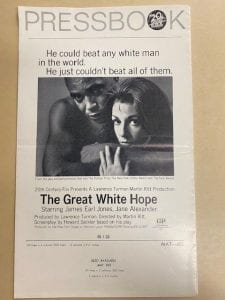New Acquisition: Michael J. Bowen Collection of Black Exploitation Film Posters and Pressbooks
Special Collections and University Archives announces with palpable excitement the acquisition of the Michael J. Bowen Collection of Black Exploitation Film Posters and Pressbooks. The genre of film recognizably identified as blaxploitation encompasses almost a decade of films from 1970 to 1979 featuring Black male and female actors in starring roles to a degree previously unprecedented, and also a time of burgeoning presence of Black screenwriters, producers, directors, and composers in the film industry. The term “blaxploitation cinema” was originally coined by the leader of the Beverly Hills-Hollywood branch NAACP acting president Junius Griffin in the 1970s (Wright, 2014). Black representation increased steadily in cinema, but could not escape the firm hold of exploitation on the blaxploitation film era.
While blaxploitation films were often directed by white producers, Black directors and writers made headway into the industry and directed, wrote, and composed highly successful films. Notable Black composers included Marvin Gaye, Isaac Hayes, Willie Hutch, and James Brown (Wright, 2014). African Americans had an historical presence holding roles in different facets of the entertainment industry. After the racial and political unrest of the Civil Rights movement and passage of the Civil Rights Act of 1964, African Americans migrated into increasingly prominent positions in film (Quinn, 2010; Wright, 2014). This increase of representation brought forth varying camps of thought concerning what may be seen as a dual nature of exploitation and empowerment in blaxploitation films. Not only was the increased representation of Black people in higher echelon film industry positions – actors, writers, directors, producers, composers – influential to conversations of exploitation and empowerment, but also the portrayal of male and female actors, cultures, environments, and storylines weighed heavily on perception of the era. Commentator Renee Ward of the Los Angeles Times, in her analysis of the blaxploitation film industry, expressed her perspective as, “‘black films, white profits’” (Quinn, 2010).
The 1970s presented an era where Black male and female actors were notably cast in leading roles, though in ways that were often stereotypical of society’s perception of Black people and Black culture. This was exemplified by casting Black actors as violent, drug dealers, gang members, promiscuous or sexualized, and lawless. The roles often depicted Black actors as residing in urban environments of poverty and violence, which, according to film historian Dan Bogle (2001), “glamorized the ghetto and depicted ghetto dwellers as symbols of authentic blackness” (Wright, 2014). Conversely, American historian Ed Guererro identifies blaxploitation film as a crucial tool to understanding the black struggle in the years following the Civil Rights movement, and to also highlight the significance of urban life and how it relates to the experiences of African Americans (Wright, 2014).
Wright (2014) identifies common themes of blaxploitation films as the following,
“(1) an urban geographic setting (the ghetto) in the North, Midwest, or West, (2) an overemphasis on outwardly expressive acts of Blackness, (3) a soundtrack of temporary soul or rhythm and blues music, (4) Black protagonists and White antagonists, (5) promiscuous men and women, and (6) an ample supply of action and violence.”
Themes identified by Wright (2014) above, including the use of action and violence in film, are seen in the cover quote of the pressbook for the film Sounder reading, “If you live through the gang wars, the pushers, the back-alley deathtraps … You Gonna Be A Star!” A promotional article in the pressbook for the movie Monkey Hustle echoed a similar theme of action and violence stating,
“A lighthearted look at a different facet of ghetto life … Filled with vignettes of life in the teeming inner-city, the story concerns itself with the fight of the area’s residents against the proposed encroachment of a freeway and their successful attempts to thwart the bureaucracy. The main opponents of the freeway are the street hustlers, who realize that the destruction of the buildings and the subsequent exodus of the residents will leave them without a turf – or victims.”
The 1970s were flooded with the release of iconic films like Shaft (1971), Coffy (1973), Foxy Brown (1974), Slaughter (1972), Blacula (1972), and the “credited launch” of the blaxploitation film era, Sweet Sweetback’s Baadasssss Song (1971), among numerous others (Wright, 2014). Shaft brought to the forefront actor Richard Roundtree, while Coffy created a role in which actor Pam Grier thrived. Composer and musician Isaac Hayes experienced a legendary career moment with the win of an Academy Award for the theme song for Shaft.
The Michael J. Bowen Collection of Black Exploitation Film Posters and Pressbooks contains approximately 145 items capturing the blaxploitation film era. Materials include over fifty pressbooks for films. Common themes in the pressbooks include synopses of the movies, cast lists, identification of production staff, publicity pages containing articles about starring actors, producers, directors, and composers, information unique to the film, including location of production, etc., pages of varied advertisements for the film, and for many pressbooks, a final page or few final pages entitled “Exploitation,” where strategies were provided to promote the film and the actors in one’s community. Also included in the collection are large posters advertising many of the approximate one hundred films chronicled in the collection.
The finding aid for this collection may be found on ArchivesSpace.
References
Quinn, E. (2010). “Tryin’ to get over”: Super Fly, Black politics and post-Civil Rights film enterprise. Cinema Journal, 49(2), 86-105. https://www.jstor.org/stable/25619772
Wright, J.K. (2014). Black outlaws and the struggle for empowerment in blaxploitation cinema. Spectrum: A Journal on Black Men, 2(2), 63-86. https://www.jstor.org/stable/10.2979/spectrum.2.2.63
Written by Alexandra Mueller, Special Projects Archivist



